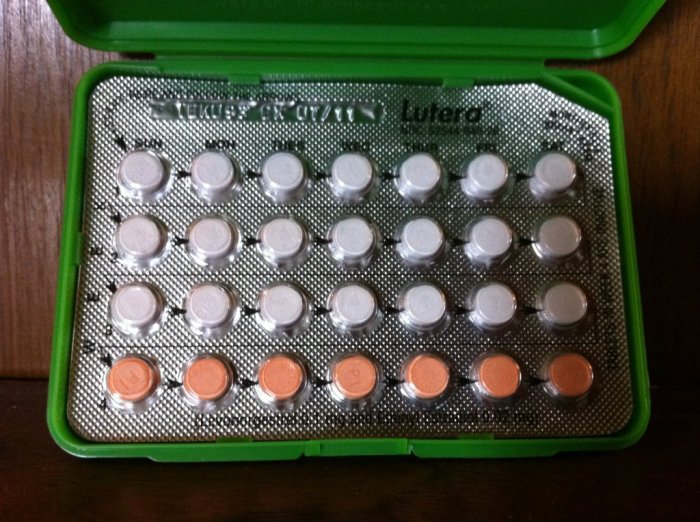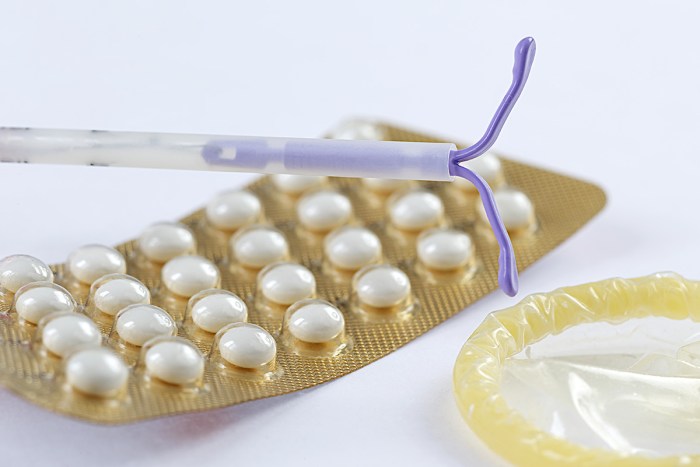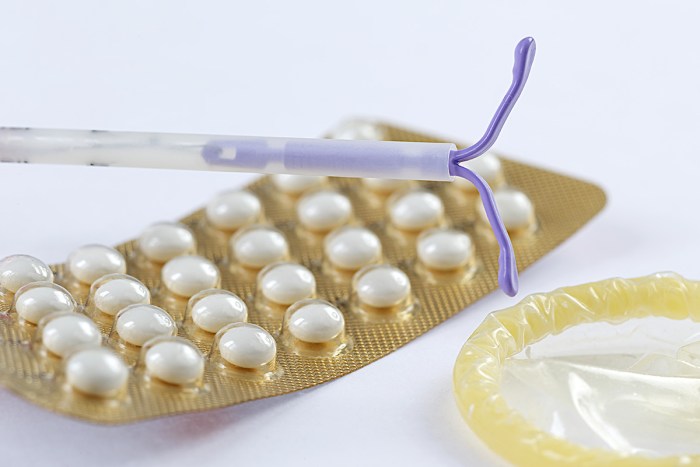A brief history on the birth control pill sets the stage for this enthralling narrative, offering readers a glimpse into a story that is rich in detail and brimming with originality from the outset. This journey traces the evolution of contraception, from early concepts and research to its global impact, highlighting the scientific breakthroughs, societal battles, and personal stories that shaped its accessibility and acceptance.
The development of the birth control pill wasn’t a sudden event; it was a culmination of decades of research, fueled by scientific advancements and driven by a need for women to have more control over their reproductive health. Early methods were often unreliable and dangerous, making the development of a safe and effective alternative a monumental achievement. This journey will explore the trials, triumphs, and controversies that accompanied the pill’s emergence.
Early Concepts and Research
The journey towards the birth control pill wasn’t a sudden leap, but a gradual evolution rooted in centuries of human understanding and experimentation. Early civilizations, while lacking the scientific tools of today, possessed rudimentary knowledge of contraception, demonstrating a persistent human desire to control fertility. This understanding, often intertwined with religious and cultural beliefs, evolved over time, paving the way for the scientific advancements that ultimately led to the modern birth control pill.The quest for effective contraception predates the 20th century.
Ever wondered how the birth control pill came to be? It’s a fascinating journey, starting with early hormonal treatments and evolving into the pills we know today. Understanding the history of these medications is important, especially when considering the implications for things like Medicaid look back periods in nursing homes, such as those outlined on Valley Ridge Health’s page on the Medicaid look back period for nursing homes.
Thankfully, research and development have significantly improved the safety and effectiveness of these options over time, leading to important choices for women and families. This historical context is crucial for understanding healthcare’s progress.
Methods varied greatly, from herbal concoctions and barrier methods to surgical procedures. However, these methods often lacked scientific backing and frequently proved unreliable or dangerous. This early work, though sometimes crude, laid the groundwork for the rigorous scientific research that followed.
Contraceptive Methods Prior to the Birth Control Pill
Before the development of the birth control pill, various methods were employed to regulate fertility. These methods often relied on observations of menstrual cycles, barrier methods, or rudimentary surgical techniques. The effectiveness and safety of these methods varied significantly, often leading to unintended pregnancies or health complications. Some notable examples include withdrawal, condoms made from animal bladders or linen, and pessaries.
Key Scientific Discoveries Leading to the Birth Control Pill
The development of the birth control pill was significantly influenced by advancements in endocrinology and reproductive biology. Researchers began to understand the hormonal mechanisms governing the menstrual cycle and ovulation. Early experiments with hormones, primarily focusing on estrogen and progesterone, provided insights into their potential for contraception. This led to the crucial discovery that administering synthetic versions of these hormones could effectively suppress ovulation, thus preventing pregnancy.
Key figures in this era of scientific exploration included researchers who identified the intricate interplay of hormones in the reproductive system.
Societal and Cultural Contexts
The societal and cultural context surrounding the development of birth control ideas was complex and often fraught with controversy. In many societies, views on family planning were deeply intertwined with religious beliefs, ethical considerations, and societal norms. This influenced the acceptance and availability of contraception methods. Public health and social issues were often at the heart of the debates surrounding the use of contraception.
Major Figures and Institutions
Several key figures and institutions played pivotal roles in the early research and development of the birth control pill. Notable researchers, like Gregory Pincus and John Rock, dedicated significant time and resources to understanding and utilizing the hormonal components for contraception. Their efforts, along with those of organizations like the Planned Parenthood Federation of America, significantly influenced the path to widespread access to birth control.
The institutions involved in this process also had a complex relationship with the medical community and broader society, navigating both support and resistance.
Comparison of Contraceptive Methods
| Method | Description | Effectiveness | Safety | Accessibility |
|---|---|---|---|---|
| Withdrawal | Withdrawing the penis before ejaculation | Low | Generally safe | Widely practiced |
| Condoms (Early Forms) | Animal bladders or linen barriers | Variable | Potential for injury | Limited availability |
| Herbal Remedies | Various herbal concoctions | Highly variable | Potential for toxicity | Commonly used, but often unreliable |
| Birth Control Pill | Synthetic hormones suppressing ovulation | High | Generally safe (modern formulations) | Increasingly accessible |
This table highlights the stark differences in effectiveness, safety, and accessibility between historical contraceptive methods and the birth control pill. The evolution from early methods to the birth control pill represents a significant advancement in reproductive health.
Development and Trials
The journey from initial concepts to the widely available birth control pill was a complex and multifaceted process, marked by scientific breakthroughs, rigorous testing, and significant ethical considerations. This period involved navigating the intricacies of hormone synthesis, dosage optimization, and the crucial task of demonstrating the pill’s safety and efficacy.The development process demanded meticulous attention to detail, from designing the optimal chemical composition to ensuring the safety and effectiveness of the medication for women of reproductive age.
This involved a phased approach, moving from initial laboratory research to large-scale clinical trials, all guided by the evolving understanding of human physiology and the potential impact of the drug.
Initial Formulations and Compositions
The quest for an effective and safe oral contraceptive began with identifying the appropriate hormones to regulate ovulation. Early formulations explored different combinations of synthetic estrogen and progestin, crucial components in mimicking the body’s natural hormonal balance. The initial focus was on creating a dosage that would effectively inhibit ovulation while minimizing unwanted side effects.
Early prototypes often included high doses of estrogen, which presented a challenge in terms of potential adverse effects.
Clinical Trials and Testing Procedures
Bringing the birth control pill to market required meticulous clinical trials. These trials were designed to evaluate the pill’s effectiveness, safety, and potential side effects in different populations. A critical aspect was the careful selection of participants, who were carefully monitored throughout the study period.Different phases of clinical trials were meticulously structured to gather comprehensive data. The early stages focused on determining safety and dosage, while later phases assessed long-term effects and compared the pill’s efficacy against other methods.
Challenges and Ethical Considerations
The testing phase of the birth control pill faced numerous ethical hurdles. One key concern was the potential impact on women’s health and reproductive rights, which led to stringent regulatory oversight and informed consent procedures. The historical context, including societal views on women’s roles and reproductive choices, further complicated the testing process.Public perception and acceptance played a critical role in the development process.
Public health authorities and medical professionals had to navigate the complexities of a controversial medical intervention.
Timeline of Key Events and Milestones
Understanding the development process requires a chronological overview of significant milestones. The progress from initial research to widespread acceptance was a long and intricate process.
- 1950s: Initial research and development of synthetic hormones.
- Early 1960s: First clinical trials begin, testing different formulations and dosages.
- Mid-1960s: The FDA approval process begins, incorporating safety and efficacy data from trials.
- Late 1960s: Widespread use of the birth control pill begins, marking a significant societal shift.
Phases of Clinical Trials
The process of testing and evaluating the birth control pill involved distinct phases of clinical trials. Each phase had specific objectives, contributing to the overall evaluation of the drug’s safety and effectiveness.
| Phase | Objectives |
|---|---|
| Phase I | Safety and dosage range determination |
| Phase II | Preliminary efficacy and further safety assessment |
| Phase III | Large-scale efficacy and safety comparison with other methods |
| Phase IV | Long-term effects and additional safety monitoring |
Introduction and Impact
The introduction of the birth control pill in the mid-20th century was a watershed moment, dramatically altering societal norms and sparking intense debate. While promising unprecedented control over fertility, it also ignited a firestorm of controversy, pushing the boundaries of medical ethics, religious beliefs, and legal frameworks. This period saw a clash between individual autonomy and deeply held societal values, shaping the trajectory of women’s health and reproductive rights for decades to come.The pill’s availability unleashed a wave of change, profoundly impacting women’s lives and challenging traditional roles and expectations.
It empowered women to take control of their reproductive futures, but also ignited a fervent debate about morality, personal responsibility, and the role of government in regulating personal choices.
Initial Reception and Public Response
The public reception to the birth control pill was mixed and often fiercely contested. While some hailed it as a medical breakthrough, others viewed it with alarm, condemning it as morally objectionable and potentially harmful. Initial concerns revolved around the unknown long-term effects, fueled by anxieties about its potential impact on women’s health and societal structures. Advertisements for the pill, often promoting its ease and convenience, became targets of criticism, highlighting the perceived shift in societal values.
Societal and Legal Battles
The introduction of the birth control pill ignited fierce societal and legal battles. Religious organizations and conservative groups vigorously opposed its widespread use, citing moral and ethical concerns. These groups argued that the pill undermined traditional family values and encouraged promiscuity. Simultaneously, feminist groups and advocates for women’s rights championed the pill’s availability, arguing for women’s autonomy and control over their bodies.
Legal challenges surrounding the pill’s distribution and use stretched across decades, with landmark court cases shaping the landscape of reproductive rights. The landmark Supreme Court cases of the 1960s and 1970s played a pivotal role in determining the legality and accessibility of birth control.
Diving into the fascinating history of the birth control pill reveals a journey of scientific advancements and societal shifts. Early attempts at hormonal contraception laid the groundwork for the modern pill, and understanding its evolution is key. However, for women with lupus, the relationship between birth control and their health becomes crucial. Factors like potential interactions and side effects need careful consideration, which is why researching resources like lupus and birth control is so important.
Ultimately, the history of the pill is about empowering women with choices and knowledge, and that includes understanding how different health conditions might affect those choices.
Key Figures and Organizations
Various figures and organizations played pivotal roles in the birth control debate. Advocates like Margaret Sanger, with her long-standing commitment to women’s reproductive health, spearheaded the movement for accessible birth control. Conversely, religious organizations and conservative groups fiercely opposed the pill’s availability, raising concerns about its moral implications. Organizations like Planned Parenthood actively promoted the pill’s use and provided crucial support to women seeking access to birth control.
Immediate Effects on Women’s Health and Reproductive Choices
The birth control pill’s immediate impact on women’s health was significant. It provided a reliable and effective method of contraception, significantly reducing unintended pregnancies. This, in turn, empowered women to pursue educational and career goals without the constant threat of unplanned pregnancies. The pill also helped reduce maternal mortality rates in some areas by allowing women to space pregnancies more effectively.
Perspectives on the Birth Control Pill
| Group | Perspective |
|---|---|
| Medical Professionals | Generally viewed the pill as a safe and effective method of contraception, recognizing its potential to improve women’s health and reduce unintended pregnancies. Early studies and research provided initial data to support this view. |
| Religious Leaders | Frequently opposed the pill’s use, arguing that it contradicted religious beliefs regarding sexual morality and reproduction. Moral and ethical concerns were paramount. |
| Women | The pill provided women with greater control over their reproductive choices and the ability to pursue educational and career goals without the constant threat of unplanned pregnancies. This empowerment was crucial in many women’s lives. |
Evolution and Improvements

The birth control pill, initially a revolutionary breakthrough, has undergone continuous refinement over the decades. Scientists and researchers have meticulously worked to improve its efficacy, reduce side effects, and tailor it to a wider range of needs. This evolution has involved not only adjustments to the hormonal composition but also a deeper understanding of how hormones interact with the body and how to deliver them most effectively.Subsequent improvements have dramatically expanded the range of options available, leading to formulations that cater to individual needs and preferences, resulting in increased accessibility and effectiveness.
The journey of refining the birth control pill has been a complex process, guided by scientific discoveries and driven by the needs of individuals seeking reliable and safe contraceptive options.
Different Pill Types
The development of various pill types reflects the understanding that one-size-fits-all approaches don’t always work in medicine. The hormonal combinations and dosages have been tailored to address specific concerns and individual needs.
- Combined pills: These pills contain both estrogen and progestin. Their effectiveness relies on the combined action of these hormones to prevent ovulation and thicken cervical mucus, making it difficult for sperm to reach the egg. This remains the most common type, with variations in estrogen and progestin formulations and dosages to cater to individual needs and minimize side effects.
- Mini-pills: These contain only progestin. They work primarily by thickening cervical mucus and altering the lining of the uterus. Mini-pills are often a better option for women who cannot tolerate estrogen or have specific health conditions.
- Extended-cycle pills: These pills provide a longer period of continuous hormone exposure. The extended cycle aims to reduce menstrual periods to fewer times per year, or even eliminate them altogether, which can be beneficial for some women. This can result in fewer side effects related to the menstrual cycle, such as cramps or mood changes.
Advancements in Hormone Action and Delivery
Understanding how hormones act within the body has led to significant advancements in birth control pill design. Researchers have focused on creating formulations that allow for more precise and controlled hormone release, minimizing fluctuations and potential side effects.
- Progestin variations: Different progestins have varying effects on the body. Research has allowed for the development of progestins that have a lower risk of certain side effects, such as blood clots or mood changes. This has expanded the range of options available to women, allowing for a more tailored approach.
- Controlled-release formulations: These formulations aim to provide a more consistent level of hormones in the bloodstream over time. This is often achieved by using specialized coatings or delivery systems that slowly release the hormones, thereby minimizing fluctuations and potential side effects.
Evolution of Side Effect Understanding
The understanding of potential side effects associated with birth control pills has evolved significantly. Early research identified some risks, and subsequent studies have provided more detailed information on the likelihood and severity of various side effects. This evolution allows for a more informed decision-making process for women considering birth control.
- Long-term health implications: Ongoing research continues to assess the long-term effects of using birth control pills, including potential links to cardiovascular health, bone health, and other conditions. The results of these studies inform recommendations for usage and potential modifications to the formulations.
- Individualized risk assessment: Modern medical practice emphasizes a personalized approach to birth control. Doctors consider a woman’s overall health, family history, and lifestyle factors when prescribing a specific pill type to minimize potential risks and maximize effectiveness.
Different Pill Types and Hormonal Compositions
| Pill Type | Hormonal Composition | Primary Action |
|---|---|---|
| Combined Pill | Estrogen + Progestin | Prevent ovulation, thicken cervical mucus |
| Mini-Pill | Progestin only | Thicken cervical mucus, alter uterine lining |
| Extended-Cycle Pill | Variable, but typically higher progestin dose | Reduce or eliminate menstruation |
Global Spread and Access
The birth control pill, a revolutionary advancement in reproductive health, has had a profound impact on women’s lives globally. However, its availability and acceptance vary significantly across different regions and cultures, highlighting the complex interplay of social, cultural, and political factors. This uneven distribution reflects disparities in healthcare access, economic conditions, and prevailing societal norms surrounding women’s reproductive rights.The global spread of the pill isn’t simply a story of its scientific development and manufacturing; it’s a reflection of the ongoing struggle for women’s equality and reproductive autonomy.
This journey is far from over, with continuous efforts needed to ensure equitable access to this crucial tool for family planning.
Variations in Availability and Acceptance
The acceptance and availability of the birth control pill are not uniform across the globe. Cultural norms, religious beliefs, and political agendas often influence the extent to which the pill is embraced. In some societies, strong religious or cultural beliefs can lead to a lower acceptance rate. Other regions may have more permissive views, fostering greater acceptance and use.
Ever wondered about the fascinating history of the birth control pill? Well, it’s a pretty incredible story, and one that touches on many aspects of women’s health. It’s amazing to think how far we’ve come in understanding reproductive health, and also, how much we still need to learn. While we’re on the subject of health and fitness, did you know that the number of calories you burn running a mile ( how many calories do you burn running a mile ) can vary greatly depending on factors like your weight and pace?
This knowledge is part of the larger picture of how we understand and improve our bodies. Ultimately, the development of the birth control pill is a testament to scientific progress and women’s empowerment.
These factors, combined with access to healthcare and education, play a vital role in shaping the uptake of birth control.
Role of Healthcare Systems
Healthcare systems play a critical role in facilitating or hindering access to the birth control pill. Robust healthcare infrastructure, including readily available family planning clinics and trained healthcare providers, is essential for effective distribution and guidance. Conversely, countries with limited access to healthcare, inadequate infrastructure, or systemic barriers to healthcare access may experience significantly lower rates of use.
Policies that either encourage or discourage the use of birth control pills influence the prevalence of their use.
Comparison of Use in Developed and Developing Countries
Developed countries often demonstrate higher rates of birth control pill usage, generally correlated with greater access to healthcare, education, and family planning services. Conversely, in developing countries, various factors, including limited healthcare infrastructure, socioeconomic disparities, and cultural norms, often result in lower usage rates. However, significant progress has been made in some developing nations, showing the importance of targeted programs and initiatives in improving access.
Availability of Birth Control Pills in Various Countries and Regions
| Country/Region | Availability | Acceptance | Factors Influencing Availability/Acceptance |
|---|---|---|---|
| United States | High | High | Extensive healthcare infrastructure, access to information, and relatively permissive social norms. |
| Sub-Saharan Africa | Variable | Variable | Limited healthcare infrastructure, cultural norms, and socioeconomic factors often hinder access. |
| Western Europe | High | High | Robust healthcare systems, widespread acceptance of birth control, and strong emphasis on women’s reproductive health. |
| South Asia | Moderate | Variable | Cultural norms and religious beliefs can impact access and acceptance, although some progress is evident. |
The table above provides a simplified overview. Specific countries within each region may show significant variations in pill availability and acceptance due to the interplay of numerous factors.
Long-Term Effects and Research

The birth control pill, while revolutionizing reproductive health, raises questions about its long-term effects on women’s overall well-being. Understanding these implications is crucial for informed decision-making and ongoing research. Extensive studies are continually investigating potential risks and benefits, aiming to provide a comprehensive picture of the pill’s impact over time.The ongoing research surrounding the birth control pill explores a wide range of potential long-term effects.
This includes investigations into how the pill influences cardiovascular health, bone density, and other aspects of women’s health. Researchers analyze data from large-scale studies to identify correlations and establish a better understanding of potential risks and benefits. A critical component of this research is the analysis of potential interactions with other medications and lifestyle factors.
Cardiovascular Health
Studies examining the long-term effects of oral contraceptives on cardiovascular health have yielded mixed results. Some studies suggest a potential link between prolonged use and an increased risk of venous thromboembolism (VTE), a condition involving blood clots. However, other research indicates that modern formulations and careful patient selection strategies have significantly mitigated this risk. It’s important to note that the specific risks vary based on individual factors like age, pre-existing conditions, and lifestyle choices.
Bone Health
The impact of oral contraceptives on bone health is another area of active research. Some studies have reported a potential association between prolonged use and a slightly reduced bone mineral density. However, the overall impact appears to be modest, and the implications for long-term bone health are complex and not fully understood. Moreover, lifestyle factors such as diet, exercise, and vitamin D levels can also significantly affect bone density, making it challenging to isolate the pill’s precise influence.
Other Areas of Research
Research is also focusing on the pill’s potential impact on other aspects of women’s health. This includes examining potential effects on the liver, gallbladder, and the risk of certain cancers. These studies aim to establish a clearer picture of the pill’s influence on various bodily functions and identify potential risks or benefits in these areas.
Summary of Key Findings
| Area of Health | Potential Impact | Key Findings/Considerations |
|---|---|---|
| Cardiovascular Health | Potential increased risk of VTE (venous thromboembolism) in some cases. | Modern formulations and patient selection have likely reduced the risk. Individual factors are crucial. |
| Bone Health | Potential for slightly reduced bone mineral density. | Lifestyle factors significantly influence bone health. The overall impact is often considered modest. |
| Other Areas | Potential effects on liver, gallbladder, and certain cancers. | Research ongoing to fully understand the nature and extent of these potential impacts. |
Cultural and Societal Impact
The birth control pill, a seemingly simple pharmaceutical invention, has profoundly reshaped societal norms and expectations, particularly concerning women’s roles and reproductive rights. Its introduction wasn’t just a medical advancement; it was a catalyst for social change, impacting family planning, career choices, and the very definition of women’s potential.The pill’s availability empowered women with greater control over their bodies and futures, leading to significant shifts in various aspects of life, from personal relationships to the global economy.
It fundamentally altered the balance of power within families and societies, ushering in an era of increased autonomy and opportunity for women.
Influence on Women’s Roles, Careers, and Educational Opportunities
The birth control pill, by reducing the unpredictable nature of fertility, provided women with a new degree of control over their lives. This control allowed them to pursue educational goals and careers previously limited by the constraints of pregnancy and child-rearing. Women were able to delay or space pregnancies, allowing them to focus on education, professional development, and personal growth.
For instance, the increased participation of women in higher education and the workforce became more evident after the pill’s introduction. Furthermore, the ability to plan pregnancies allowed women to prioritize personal and professional aspirations, leading to more diverse and fulfilling life paths.
Impact on Family Planning and Demographics
The pill dramatically impacted family planning practices worldwide. Before its widespread adoption, unplanned pregnancies were more common, leading to a higher rate of unintended births. The birth control pill empowered individuals to make informed decisions about family size and spacing, leading to more deliberate family planning choices. This trend was reflected in declining birth rates in many regions, altering population dynamics and influencing the future composition of society.
Consequently, the average family size decreased, and more women chose to pursue careers and education alongside family life.
Evolution of Attitudes and Perspectives on Women’s Reproductive Health
The introduction of the birth control pill sparked a significant evolution in societal attitudes towards women’s reproductive health. Previously, reproductive health was often seen as a primarily private and personal matter, governed by traditional norms and religious beliefs. The pill’s availability challenged these norms, prompting public discourse on women’s rights, bodily autonomy, and reproductive freedom. The ensuing debate highlighted the need for greater access to comprehensive reproductive healthcare and education, contributing to the advancement of women’s rights movements globally.
The pill also contributed to the development of reproductive healthcare services and advocacy groups.
Changes in Women’s Social Roles Across Time Periods, A brief history on the birth control pill
| Time Period | Women’s Social Roles |
|---|---|
| Pre-1960s | Limited educational and career opportunities, primarily focused on domestic roles. Pregnancy and child-rearing were often viewed as the primary life goals. Limited access to birth control. |
| Post-1960s (Initial Years) | Increased educational and career opportunities. Women started to enter traditionally male-dominated professions, although significant gender gaps persisted. Greater control over family planning. |
| Post-1980s | Continued advancement in women’s roles, with increased participation in leadership positions and senior-level roles. Continued evolution of family planning choices, including increased use of other methods of birth control and adoption. |
| Present Day | Women’s roles are more diverse and dynamic, with women pursuing various career paths and achieving leadership positions across all sectors. Increased access to information and resources about reproductive health and family planning. Ongoing debate and evolution in societal attitudes toward women’s reproductive rights. |
Final Summary: A Brief History On The Birth Control Pill
In conclusion, the journey of the birth control pill is a compelling testament to human ingenuity and resilience. From its initial conception to its widespread use, the pill has profoundly impacted women’s health, reproductive choices, and societal norms. The story is not without its challenges and complexities, reflecting the ongoing debate about women’s rights, healthcare, and ethics. This brief history underscores the importance of continued research and dialogue as we navigate the evolving landscape of reproductive health.
















